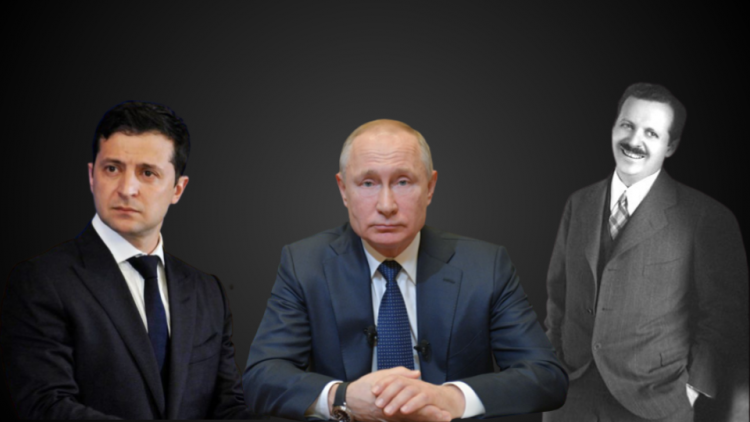You unfriend friends. You block families. You unfollow relatives. You fight strangers. Thatâs what propaganda did to us today, tomorrow, and days to come.
In my house, Dad’s always right.
His name isn’t Vladímir Vladímirovich Pútin of Russia, let alone Volodymyr Oleksandrovych Zelenskyy of Ukraine.
He’s from Cianjur, a city founded by Muslim scholars in 1677, in West Java province, Indonesia.
He’s the rightest by being the loudest. If you, children, talk back to him, that’s a sin. Slaps on the thigh and the shoutings are almost guaranteed. You can’t be righter than him even if you actually do.
Growing up as a Muslim child, it’s dogmatic to believe that a father is the head of the family, the Imam, the leader you have to always respect even when they’re wrong.
The house is our country. He shall not show any sign of weakness. No sorry. No thank you. No privacy. King of the jungle. He is the nation—L’état, c’est moi!
Like many state leaders, he had to retain power on a daily basis, or even in seconds. You’ve got to show authority, legitimacy, and often self-centeredness.
Keep the order intact – that’s how you survive.
The easiest and publicly acceptable way to achieve that goal is by cherry-picking some Quranic verses, hadiths, and cultural sayings favourable to the status quo or the leader. Add with some other religious preaches about respecting the leader of the house no matter what.
As a leader, you must reiterate those favourable messages and arguments to stay at the throne.
Critical thinking wasn’t a thing in a patriarchal, pseudo-religious society. That’s a vigilante.
Violate all that, child, you’re going straight to hell.
That’s how I understand propaganda—by growing up with it and living it.
Defining propaganda
As a now-slightly-reasonable grown-up man, you make peace with the past. You forgive the wrongs. You accept whatever and whoever in your life just the way they are.
But, you don’t forget. Instead, you learn. You think and contemplate. That’s how I approach the concept of propaganda I learned at my house in my adult life, as you should.
As the war between Russia and Ukraine heated up, everybody talked about ‘propaganda’ on social media. However, are we just term-dropping without really fathoming it?
Let’s go deeper – some of my favourite definitions of propaganda.
- “It’s the management of collective attitudes by the manipulation of significant symbols” (Laswell, 1927).
- “It’s the expression of opinions or actions carried out deliberately by individuals or groups with a view to influencing the opinions or actions of other individuals or groups for predetermined ends and through psychological manipulations” (the Institute for Propaganda Analysis, 1937/1972).
- “It’s communication designed to manipulate a target population by affecting its beliefs, attitudes, or preferences to obtain behaviour compliant with political goals of the propagandist” (Benkler et. al., 2018).
Propaganda is intentional. It relies on manipulation using misleading information. And its purpose is to support political or social goals by managing behaviour and perception.
When, like today, information is free-flowing from everyone everywhere, how do we identify propaganda?
Indeed, it’s hard to “coherently distinguish ‘propaganda’ from a variety of other terms that refer to communication to a population that has a similar desired outcome: persuasion, marketing, public relations, and education” (Benkler et al., 2018).
I’d agree with Gustave Le Bon’s notion on propaganda in 1903 that’s relevant to date. The leading French polymath said propaganda is a way to shape the opinions and beliefs of crowds to move them towards specific goals.
Propaganda isn’t only changing a person’s perception of the environment via symbolic ways, but also changing the target audience’s behaviour to change the environment or condition.
Mediations through TV, radio, online news, newspapers, religious preachers, thugs, and others always act in two directions. It aims:
- to change the target audience’s perceptions
- to shape the target audience’s activities in relation to the environment (or lack of action, if the activity needs to be neutralized)
The target audience receives a message either in public spaces (posters, cinema, newsstands, loudspeakers) or in private spaces (TV, smartphone, radio), and chooses to act according to the message they received.
Propaganda infiltrates our most intimate spaces. We interact with our laptops and mobile devices. It moves from the living room to the bedroom, following us as we travel to work on crowded public transport. It remains with us during office time. We can wake up and fall asleep with propaganda in our hands. It finds us at school, in the bathroom, or at the cafe.
Social networking platforms combine news consumption with social interaction, turning social interaction into a mechanism of content proliferation and selective amplification (Zuckerman, 2018).
Watch those bots of pro-and contra-government, the buzzers and online media of those supporters and opposers influencing many aspects of netizens’ life, paid and organic participatory netizens’ propaganda every single day—how wonderful.
You unfriend friends. You block families. You unfollow relatives. You fight strangers
That’s what propaganda did to us today, tomorrow, and days to come.
Communicating propaganda
Edward Bernays, the father of Public Relations and the author of Propaganda (1928), pioneered the use of mass psychology and other social sciences to design his public persuasion campaigns.
He said, “if we understand the mechanism and motives of the group mind, is it not possible to control and regiment the masses according to our will without their knowing about it? The recent practice of propaganda has proved that it’s possible, at least up to a certain point and within certain limits.”
One of Mr Bernay’s famous works was The Torches of Freedom or Easter Parade of Lucky Strike for the American Tobacco Company in 1929. He found that women weren’t smoking Lucky Strikes because the green packages clashed with almost every women’s garment colour. But, the president of American Tobacco refused to change the package.
So, in the name and wisdom of propaganda, Mr Bernays:
- staged a demonstration at the Easter parade, having fashionable young women flaunt their “torches of freedom” (read: cigarettes)
- promoted Lucky Strikes by convincing women that the forest green hue of the cigarette pack was among the most fashionable of colours
- he promoted cigarettes as both soothing to the throat and slimming to the waistline
The successes: innumerable window displays and fashion shows at that time.
It all shows how critical thinking, strategic thinking, scientific thinking, and communication skills are qualities any propagandist communicator is pivotal to master today more than ever.
You see, who wants to be as successful as my Dad?
Now, slack off a bit. Loosen up the tensions. Let’s bump ideas.Let’s talk about how persuasive communications might help your businesses. This time, of course, with a moral compass and ethics in place.


















